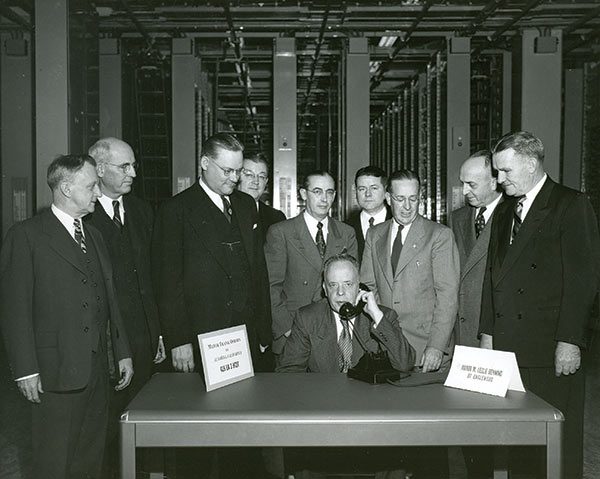
As mayor of Englewood, M. Leslie Denning had made plenty of phone calls, but never one that generated this much attention. On November 10, 1951, Denning picked up the receiver of his black rotary phone and dialed 10 digits. Listening in at his side were nine men in suits from AT&T and Bell Labs.
Three time zones and about 3,000 miles away, Frank Osborne, mayor of Alameda, California, picked up his ringing phone. A test of technology had been passed.
The two mayors made small talk; more importantly, according to the AT&T Tech Channel website, they made communications history with the completion of the first direct-dial transcontinental phone call.
It took just 18 seconds for that first cross-country connection to go through. In 1915, an early attempt at a transcontinental call from San Francisco to New York required as many as five operators and 23 minutes to complete. Even at the time of Denning’s call to his California counterpart, routine long-distance calls required the intervention of an operator.
The direct-dial call was made possible in part by the introduction of area codes four years earlier and automated switching systems. It was a leap that would change the way we live.
“Direct-dial capabilities removed the costs of servicing long-distance calls,” says Audrey Curtis, director of the Telecom Management Program at Stevens Institute of Technology in Hoboken. “There are shorter holding times for the placement of a call due to the automation, and therefore less cost incurred if the call does not complete—due to no answer or a busy signal. The operator costs associated with routine long-distance calls also were eliminated.”
Prior to the changes, when a customer placed a long-distance call operators would have to ask, “Number, please?”.
“Removing operators from the role of dialing for the consumer or business caller also [changed] the psychology of placing calls,” Curtis says. “It became more private—good for business and private calls—and placing a long-distance call became more spontaneous. Data show consistent increases in call volumes following this innovation.”
Bell Labs in New Jersey, including the Holmdel site, played a major role in this communications advance with the introduction of the North American Numbering Plan, which assigned area codes to the continent in 1947, including the 201 area code for New Jersey. “The numbering plan was a necessary step,” Curtis says.
Englewood was chosen as the site for the first call, in part because of a modified switching system that allowed long-distance calls throughout New Jersey and parts of New York.
The advances made in automation after World War II continued to reap dividends decades later. “With direct-distance dialing, fax and telephone-supported online access were enabled,” says Curtis, a former Bell Labs and AT&T Labs employee. (Broadband Internet services, on the other hand, use Internet addressing and not phone numbers with area codes.)
Tom Wilk is a frequent contributor.
